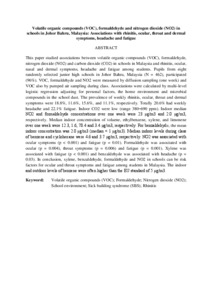Citation
Norback, Dan and Hashim, Jamal Hisham and Hashim, Zailina and Ali, Faridah
(2017)
Volatile organic compounds (VOC), formaldehyde and nitrogen dioxide (NO2) in schools in Johor Bahru, Malaysia: associations with rhinitis, ocular, throat and dermal symptoms, headache and fatigue.
Science of The Total Environment, 592.
153 - 160.
ISSN 0048-9697; ESSN: 1879-1026
Abstract
This paper studied associations between volatile organic compounds (VOC), formaldehyde, nitrogen dioxide (NO2) and carbon dioxide (CO2) in schools in Malaysia and rhinitis, ocular, nasal and dermal symptoms, headache and fatigue among students. Pupils from eight randomly selected junior high schools in Johor Bahru, Malaysia (N = 462), participated (96%). VOC, formaldehyde and NO2 were measured by diffusion sampling (one week) and VOC also by pumped air sampling during class. Associations were calculated by multi-level logistic regression adjusting for personal factors, the home environment and microbial compounds in the school dust. The prevalence of weekly rhinitis, ocular, throat and dermal symptoms were 18.8%, 11.6%, 15.6%, and 11.1%, respectively. Totally 20.6% had weekly headache and 22.1% fatigue. Indoor CO2 were low (range 380–690 ppm). Indoor median NO2 and formaldehyde concentrations over one week were 23 μg/m3 and 2.0 μg/m3, respectively. Median indoor concentration of toluene, ethylbenzene, xylene, and limonene over one week were 12.3, 1.6, 78.4 and 3.4 μg/m3, respectively. For benzaldehyde, the mean indoor concentration was 2.0 μg/m3 (median < 1 μg/m3). Median indoor levels during class of benzene and cyclohexane were 4.6 and 3.7 μg/m3, respectively. NO2 was associated with ocular symptoms (p < 0.001) and fatigue (p = 0.01). Formaldehyde was associated with ocular (p = 0.004), throat symptoms (p = 0.006) and fatigue (p = 0.001). Xylene was associated with fatigue (p < 0.001) and benzaldehyde was associated with headache (p = 0.03). In conclusion, xylene, benzaldehyde, formaldehyde and NO2 in schools can be risk factors for ocular and throat symptoms and fatigue among students in Malaysia. The indoor and outdoor levels of benzene were often higher than the EU standard of 5 μg/m3.
Download File
![[img]](http://psasir.upm.edu.my/63693/1.hassmallThumbnailVersion/Volatile%20organic%20compounds%20%28VOC%29%2C%20formaldehyde%20and%20nitrogen%20dioxide%20%28NO2%29%20in%20schools%20in%20Johor%20Bahru%2C%20Malaysia.pdf)  Preview |
|
Text (Abstract)
Volatile organic compounds (VOC), formaldehyde and nitrogen dioxide (NO2) in schools in Johor Bahru, Malaysia.pdf
Download (109kB)
| Preview
|
|
Additional Metadata
Actions (login required)
 |
View Item |

